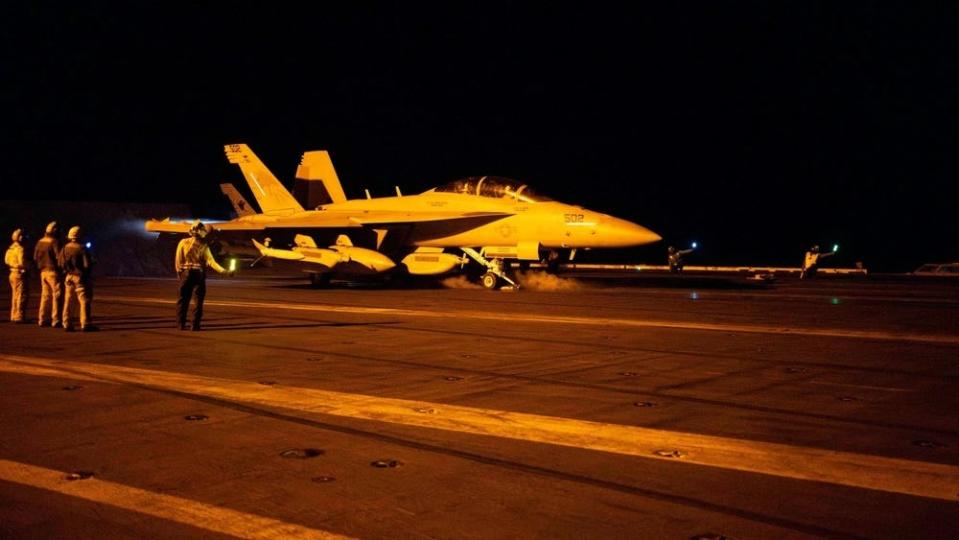Photos show US carrier's nighttime missions to counter Houthi rebels
The US and UK launched airstrikes against Houthi rebels in Yemen earlier this month.
The strikes were in retaliation to Houthi attacks on commercial shipping vessels in the Red Sea.
Photos of the nighttime flights demonstrate the power of the US response.
The US and UK launched a series of airstrikes against Houthi militants in Yemen earlier this month.
The strikes came in retaliation to the Iranian-backed rebel group's attacks on commercial shipping in the Red Sea, which are ongoing despite repeated warnings from the US and its allies.
On January 12, armed forces led by the US and UK, with support from Australia, Bahrain, Canada, and the Netherlands, used more than 100 precision-guided munitions on more than 60 Houthi targets in Yemen.
Despite the strikes, Houthi rebels continued to attack commercial shipping vessels. The New York Times reported that the Houthis likely hid most of their missiles and drones before the US-led air attacks, allowing them to retain about 75% of their firepower.
A little over a week later, the US launched more unilateral strikes on eight Houthi targets, including an underground storage site and key missile and air surveillance locations.
"These precision strikes are intended to disrupt and degrade the capabilities that the Houthis use to threaten global trade and the lives of innocent mariners," the US, UK, and its allies said in a joint statement following the strikes.
Photos and video footage show the flight operations aboard the aircraft carrier, the USS Dwight D. Eisenhower, ahead of the intense strikes.
USS Dwight D. Eisenhower

The Carrier Wing 3, one of the oldest air wings in the Navy, operates aboard the Ike, a nuclear-powered Nimitz-class aircraft carrier. The air wing includes aircraft like the F/A-18 Super Hornet, E-2 Hawkeye, and EA-18G Growler.
Ready for takeoff

Videos showed the aircraft blasting from the flight deck of the Eisenhower in the dead of night.
F/A-18 Super Hornet

Among the aircraft aboard the Eisenhower is the F/A-18 Super Hornet, a twin-engine supersonic fighter jet that can be armed with air-to-surface missiles and bombs.
The combat jet can travel at Mach 1.8 (about 1,380 mph) and fly a range of 1,275 nautical miles and altitudes higher than 50,000 feet. There are two versions of the Super Hornet — a two-seater F model and a single-seat E model, like the one shown above.
A US official told Fox News that over 15 Super Hornets were used in the strikes out of a total of 22 fixed-wing aircraft from the aircraft carrier, the USS Dwight D. Eisenhower.
E/A-18G Growler

The E/A-18G Growler, a variant of the F/A-18 Superhornet, was also used in the airstrikes. The US Navy is the sole operator of the Growler, though it is sometimes cooperatively operated by Australian armed forces.
The two-seater electronic warfare jet can reach altitudes of up to 50,000 feet and has a range of 850 nautical miles with its full payload. It can carry two Advanced Medium-Range Air-to-Air Missile (AMRAAM), up to three radar jamming pods, and three air-to-surface tactical missiles.
It can also carry two 480-gallon external fuel tanks.
E-2C Hawkeye

The E-2C Hawkeye is an all-weather, twin-turboprop tactical aircraft dubbed the "eyes of the fleet." It can carry up to five crewmembers and has a massive radar above its fuselage that helps the aircraft to serve airborne early warning and battle management tasks.
First operational in 1973, the Hawkeye was the first carrier-based aircraft "designed from the outset for the all-weather airborne early warning and command and control mission," according to the US Navy.
The newest variant of the E-2C, the Northrop Grumman E-2D Advanced Hawkeye, celebrated its 15th anniversary since its first flight in August 2022.
Read the original article on Business Insider

 Yahoo News
Yahoo News 
